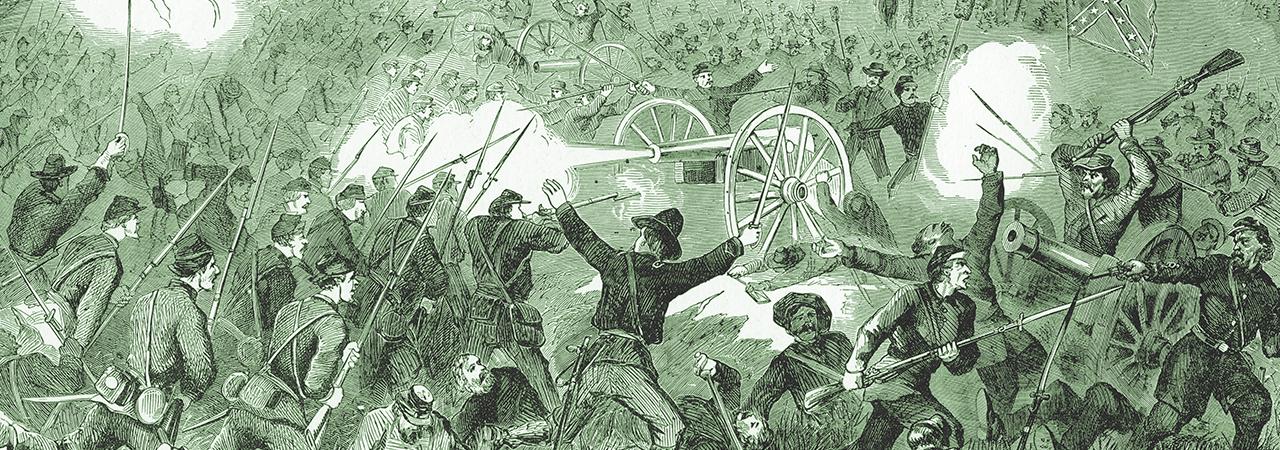
Champion Hill
Baker's Creek
Hinds County, MS | May 16, 1863
In the summer of 1863, Union forces under the command of Maj. Gen. Ulysses S. Grant defeated Confederate General John Pemberton at the Battle of Champion Hill, the largest of Grant’s Vicksburg Campaign. The twin victories at Champion Hill and Big Black River the next day forced the Confederates into a doomed position inside the fortifications of Vicksburg.
How It Ended
Union victory. After fighting a bloody struggle along Champion Hill, Pemberton realized his army could not fight against Grant's much larger force and decided to fall back from the battlefield and retreat towards the Big Black River Bridge. To help save the army, Pemberton tasked Lloyd Tilghman's brigade to provide a rear-guard action that cost Tilghman his life. However, this action allowed Pemberton to retreat from the area.
In Context
The Mississippi River was the primary conduit for supplies and communication through the south and a vital lifeline for goods going north. To Confederate President Jefferson Davis, Vicksburg was the "nailhead that holds the South's two halves together." President Abraham Lincoln once remarked, “Vicksburg is the key! The war can never be brought to a close until that key is in our pocket.” After two weeks of tough marching and fighting, Grant managed to move his army on the road toward Vicksburg. Pemberton attempted to stop Grant and engaged the Union army at Champion Hill.
On May 14th, Federal forces under the command of Ulysses S. Grant captured Jackson, Mississippi's state capital. Once the capital was in Union hands, communication between Pemberton and General Joseph Johnston was cut. Pemberton began to receive conflicting reports from Johnston about whether or not to attack the Federals at Clinton. Still, he and his subordinate commanders decided to attack near Raymond, along the Federal supply line.
As the sun rose on the 16th, elements of Pemberton's army began to skirmish with the vanguard of Grant's army. Pemberton received another letter from Johnston, who directed him to move his army towards the Federals at Clinton. Pemberton selected General William W. Loring's division to hold the Raymond Road while the rest of the army moved north.
Pemberton's new line formed a defensive position along a ridge overlooking Jackson Creek, covering the Middle Road and Raymond Road to the south. Soon General Stephen D. Lee, posted atop Champion Hill, warned Pemberton of a Union column moving on the Jackson Road toward the unprotected left flank, threatening to cut the Southerners off from Edwards Station and the route to Vicksburg. Pemberton shifted his troops north to cover the hill and Jackson Road.
When Grant arrived at Champion Hill around 10 a.m., he ordered an attack led by the divisions of Brig. Gen. Alvin Hovey and Maj. Gen. John A. Logan. By 11:30 a.m., Hovey's and Logan's brigades had reached the Confederate main line, and at about 1 p.m., they took the crest while the Confederates retired in disorder. Nevertheless, the Federals swept forward, capturing the crossroads where the Middle and Jackson Roads met, closing Pemberton's escape route.
Loring sent brigades to support the Confederate left and center to turn the tide in the Confederates’ favor. After a brief counterattack by General John S. Bowen that pushed the Federals nearly back to the Champion house, Grant sent in the division of General Marcellus Crocker. At the same time, General John A. McClernand's XIII Corps threatened the Confederate right.
2,457
3,840
Ultimately, Pemberton's men could not withstand the larger Federal assaults and thus he ordered his men to use the one escape route still open: the Raymond Road crossing at Baker's Creek to the southwest. To cover the army's retreat, Pemberton tasked General Lloyd Tilghman's brigade and some artillery to form a rearguard. Although they held the crossing, there were numerous casualties, including Tilghman himself. By nightfall, the Confederates were in full retreat towards Vicksburg. However, Loring's division was blocked from crossing the river and decided to join Johnston's men north of Jackson.
In the summer of 1863, Union General Ulysses S. Grant launched a campaign to capture Vicksburg. While waiting for Grant, Pemberton received conflicting orders from the President and his department commander. President Jefferson Davis ordered him to save Vicksburg at all costs. In contrast, department commander General Joseph E. Johnston ordered him to move out of the city and attack the Federal forces at Clinton. Pemberton decided not to follow Johnston’s orders and attack the Federal supply lines near Raymond. However, by the 16th, Pemberton was again ordered to follow Johnston’s orders, forcing him to change his plans and collide with Grant near Champion Hill.
Once the Federal plans of the attack became apparent to John Pemberton, he tried to rush reinforcements to the top of Champion Hill. Despite ordering General William W. Loring to come to his aid, Loring was obligated to stay at his position near the Raymond Road, citing a large Federal force to his front. By the afternoon, after repeated orders, Loring finally moved toward the desperate fight atop Champion Hill. However, it was too late for Loring to make an impact on the fighting. During the Confederate retreat, Loring’s men were cut off from the rest of the Southern army and were forced to withdraw towards Joseph Johnson’s army north of Jackson. Controversy soon arose between Loring and Pemberton for his unwillingness to follow orders and his late arrival on the battlefield.
Champion Hill: Featured Resources
All battles of the Grant's Operations Against Vicksburg Campaign
Related Battles
32,000
22,000
2,457
3,840










